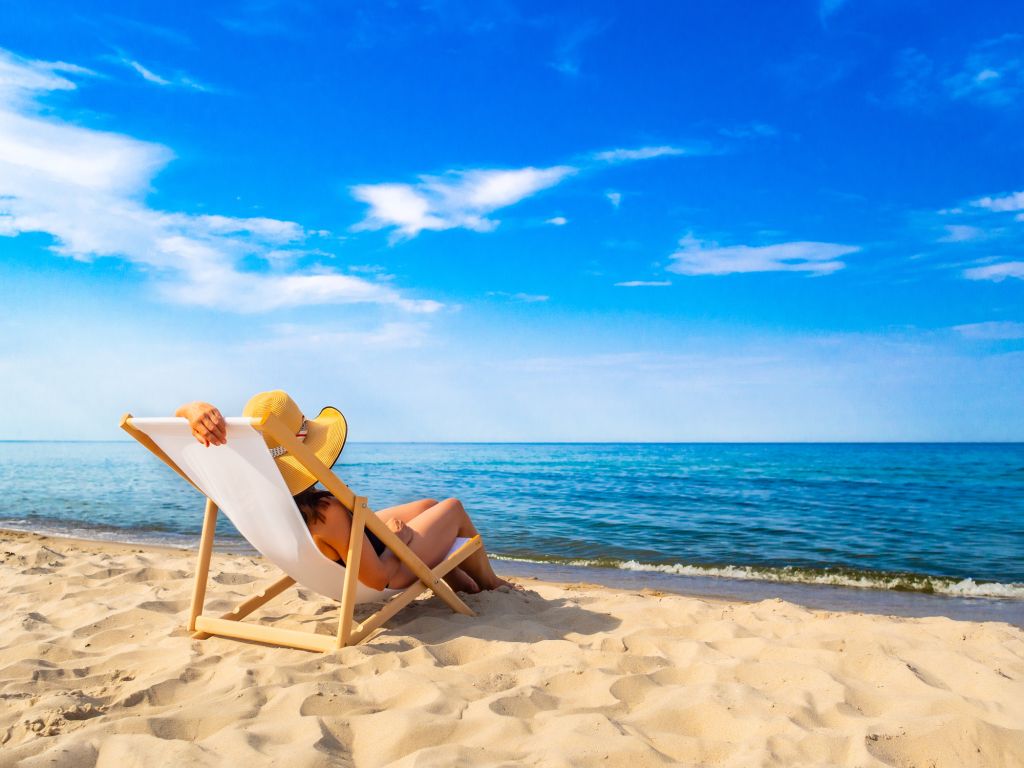Published March 13, 2024 • 11 Min Read
There’s nothing like a road trip. A car full of your favourite people, abundant snacks and your best music. A sense of independence as you set your own route and schedule. If you’ve never gone road tripping, buckle up for an adventure and make the most of it with these tips for an epic drive.
A U.S. road trip lets you see sights you might miss by air, explore regional cultures like a local and discover offbeat attractions – think The World’s Largest Ball of Paint, Wild Blueberry Land or The Spam Museum. It also gives you an opportunity to play a mean game of 20 questions, contemplate your top albums of all time and discover new podcasts.
And while there is some magic in the idea of hopping in the car, making only left turns and seeing where the road takes you, the real key to a successful road trip is preparation. From your route to your overnight stops to your gas and your food, having a plan – that you at least loosely follow – is your ticket to a great time.
Four steps to take as you plan out your road trip
Step 1: Map it out
So, where do you want to go? Do you have an end destination in mind or is there a collection of sites you’re looking to hit? Deciding where you want to go and what you want to see is obviously your first step.
Not sure what inspires you? Consider popular road trip themes that can inform your route through the U.S., such as movie set locations, baseball parks, scenic hikes, amusement parks or county fairs. Perhaps you embark on a quest to find the country’s best corn dog?
As you plan your route, there are several important factors to keep in mind:
The weather
If you’ve ever driven through Buffalo in the winter and dealt with lake effect snow, or New Mexico in the summer and faced the “Southwest Monsoon”, you probably know that weather can significantly affect your enjoyment (and safety) of the open road. Whether your road trip is anchored by your vacation time or your destination, research the weather along your route in advance so you know what you might be getting into.
Your overnight stays
There’s nothing worse than driving for 12+ hours and being faced with “no vacancy” signs when you’re ready to stop. Keep in mind that if you’re thinking of camping, sites can get booked up quickly in the summer so it’s best to plan out your stops well in advance. The same goes for popular hotels along major interstates – the ones with the best reviews get busy quick. Having your overnight stops booked before you leave will be a weight off your shoulders as you travel.
Your refueling/ recharging points
Whether you’re driving a gas-powered or electric vehicle, it’s important to know where there are stations and most importantly, where there aren’t. While there are roughly 150,000 gas stations across the U.S. (and just as many EV stations), there are long stretches of highway where there isn’t a station for miles. While you don’t need to plan out every pit stop, knowing what’s available along your route is an important planning factor.
The secondary sights
While your road trip might be focused on hitting 10 U.S. ballparks or a series of vineyards, don’t lose sight of what else you might discover along your route. The U.S. is chock full of interesting attractions that you can really only encounter when traveling across the country by car. From famous ice cream parlours to stunning hikes to kitschy museums, there is so much to see when you scratch the surface of what smalltown USA offers.
Step 2: Prep your car
Whether you’re planning a three-day or three-week getaway, your car has to be in tip-top shape to safely shuttle you and your passengers on your U.S. road trip. While this isn’t an exhaustive list, here are some basic steps to take to get your car road-trip-ready.
-
Get a tune-up. Before you hit the road, spring for an inspection, oil change and tire rotation to ensure your car is prepped and primed for long distances.
-
Top up your fluids. No matter what time of year you’re driving, there’s plenty of grit on the roads – make sure your washer fluid is replenished and pack some extra to keep on hand.
-
Check your emergency car kit. Ensure you’ve got some basic tools (screwdriver, wrench, socket set), jumper cables, a spare tire and extra oil. If traveling in the winter, be sure to add a shovel, ice scraper and some blankets in case of emergency.
-
Check your roadside coverage. Whether you have coverage through your leasing company, car manufacturer or insurance provider, ensure you’re covered for 24/7 assistance south of the border.
-
Bring an extra key. It’s always a good idea to entrust one of the passengers with a second key, in case the driver misplaces theirs. Be sure to keep the keys separate for an extra layer of security.
Step 3: Pack right
Unlike when flying, there’s no additional fee for extra bags… so you can go crazy on the packing, right? Well, not so fast. The supplies you need to bring along on your road trip can add up fast, so it’s wise to take a smart and balanced approach to packing clothes, shoes, toiletries, etc.
Beyond your personal items, be thoughtful about your packing and cover off the essentials first. Here’s a list of must-haves on your road trip:
-
Offline maps. Cell service can be spotty in certain parts, so you don’t want to have to rely solely on your phone’s navigation services. Plus, paper maps or atlases can give you a great big-picture view of your trip that you can’t get from a small screen. Besides, you may want to preserve both your battery and your data plan!
-
Food and water. A selection of snacks is important to keep spirits high and hunger at bay during your trip. While it can be tempting to load up on chips and candy, healthy, lower-sugar items are important to fend off fatigue and stomach aches. Keep in mind, you’re not allowed to take fruit across the border, so it’s best to buy your produce once you’re in the U.S. Be sure to pack plenty of water too and keep replenishing as you go.
-
Sunglasses (and regular glasses, should you need them!).
-
Phone chargers (with adapters for the different plug configurations you may find as you travel).
-
Toilet paper, hand soap, towel. Because let’s face it, not ever rest stop is a five-star experience.
Step 4: Let it flow
So, you’ve made your plans and your route is set. But before you push off, it’s important to look at your roadmap as a guideline versus something that’s set in stone. Remember, one of the great things about a road trip is that you make the rules – and while it’s important to be prepared, it’s just as important to approach your trip with a sense of adventure and flexibility. After all, things can go wrong (you could get lost, someone could get carsick, you may experience car trouble) and you’ll need to adapt along the way. On the other hand, you may encounter a charming server at a roadside diner who gives you the inside scoop on a must-see local attraction a few miles away.
Giving your plan some breathing room can significantly boost the enjoyment of your trip and open the door to some once-in-a-lifetime moments.
Here are some tips to keep in mind:
-
Don’t try to cram too much driving into a single day. While you may want to get to your destination as quickly as possible, driving multiple 12-hour days can be exhausting and far from enjoyable. By planning for shorter driving days, you have room to explore.
-
Chat with the locals. Hidden gems aren’t often found online. Striking up a conversation with shop owners, gas station attendants, servers and hotel staff can help you uncover the best local restaurants, attractions and shortcuts!
-
Give yourself space. Depending on how many people are in your vehicle, you may be in pretty cramped quarters for long periods of time. When you stop for the night, consider booking separate rooms and maybe splurging on something nicer if you’ve been on the road a while and moods are souring.
When you combine an open mind with the open road, the path ahead is limitless!
How to save money on your U.S. road trip
One of the great things about a road trip is that it can be as affordable as it can be fun. There are many ways you can stretch your dollar farther on a road trip south of the border. Here are some ideas to keep the costs down and the fun factor high.
Pack your own food
While it’s important to make stops throughout your driving day, they don’t always need to be at fast-food restaurants. By packing food – especially early in your trip – you can save money and eat healthier. There are plenty of rest stops with picnic tables so you can easily lay out your spread and dig in.
Buy things in states with lower taxes
If you’re keen to do some shopping while on the road, try to plan it for your travels through lower-tax states. New Hampshire, Delaware, Montana and Oregon have 0% tax, and many others have low tax rates, including Alabama, Missouri, North Carolina and Colorado. When planning your route, check the tax rates and coordinate your shopping accordingly. These states are also great places to stock up on your supplies!
Gas up in cheaper states
Gas is typically cheaper in the U.S. than it is in Canada, but some states have consistently lower prices for fuel. Texas, Mississippi, Alabama, Arkansas and Ohio are among the dozen or so states that boast low costs at the pump. Again, see where your route takes you and highlight where it’s best to gas up.
Choose a cross-border banking partner
With some cross-border banking solutions, you can avoid foreign exchange fees on U.S. purchases, which can add up over the course of a trip. The right banking partner can also give you access to no-fee ATMs across the U.S.
Tap into offers and discounts
Depending on who you bank with or where you work, you might have a world of offers and discounts available at your fingertips. Many larger employers have perk programs for their employees. Check with your boss or HR team to see if your job comes with perks at hotels and destinations. Some banks also come with their own travel perks. For example, RBC Cross-Border Banking clients get access to discounts and perks at hotels, attractions, restaurants and theme parks through valuable partnerships and providers. You can find some of the perks available here.1
Your next U.S. road trip could be a short weekend getaway or a trip of a lifetime. Whenever and wherever you’re going, hit the open road with a sense of confidence, adventure and limitless possibilities with the right mix of preparation and flexibility.

Travelling to the U.S. on a budget?
Set up your U.S. banking and credit card before you travel to make life simpler.
1 You must enroll as an RBC Bank (U.S.) client to take advantage of these exclusive offers. These offers are subject to their respective terms and conditions which can be accessed upon enrollment. Offers are subject to change and can be withdrawn at any time. These companies are not affiliated with RBC Bank and RBC Bank is not responsible for the offers provided by each company or their respective terms and conditions.
This article is intended as general information only and is not to be relied upon as constituting legal, financial or other professional advice. A professional advisor should be consulted regarding your specific situation. Information presented is believed to be factual and up-to-date but we do not guarantee its accuracy and it should not be regarded as a complete analysis of the subjects discussed. All expressions of opinion reflect the judgment of the authors as of the date of publication and are subject to change. No endorsement of any third parties or their advice, opinions, information, products or services is expressly given or implied by Royal Bank of Canada or any of its affiliates.
Share This Article






